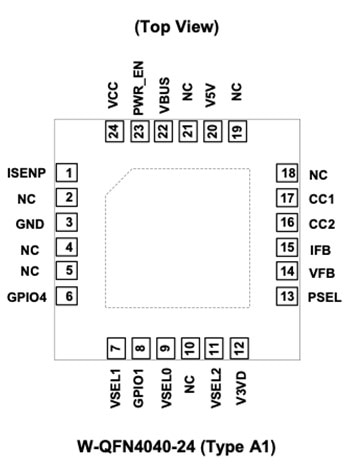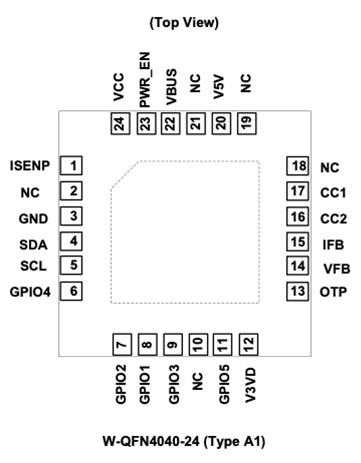USB PD 3 受电端控制器为 USB Type-C 应用提供支持
投稿人:DigiKey 北美编辑
2024-06-27
随着地区监管机构开始要求采用基于标准 USB Type-C® 电缆和连接器的通用充电解决方案,专用设备充电器的窗口期正在迅速关闭。要赶在地区要求出台之前满足这一标准,产品设计人员可以采用 USB Power Delivery (PD) 受电端控制器在设备和充电器之间协商功率传输,从而优化自己的应用,迎接新时代的到来。
2024 年 12 月后,在欧盟,任何需要最高 100 W 功率的有线充电设备都必须采用符合 USB PD 规范的 USB Type-C 充电端口(笔记本电脑在 2026 年前暂时不受此规定限制)。此外,印度和沙特阿拉伯的相同法令将于 2025 年在生效,随后加利福尼亚州将于 2026 年生效。
USB Type-C 自身只能在 3 A 电流下提供 5 V 电压,总功率为 15 W。要实现 100 W 功率,需要符合 USB PD 3.0 或 USB PD 3.1 规范,以确保 Type-C 连接器在传输高速数据的同时,能够协商更高的电压。
USB PD 3.0 能够传输高达 100 W 的功率,以及 5 V、9 V、15 V 和 20 V 的固定电压,最大电流为 5 A。最新的 USB PD 3.1 规范包含扩展功率范围 (EPR) 和高级电压供应 (AVS),可将输出功率提升至最高 240 W,并新增了 28 V、36 V 和 48 V 三种固定电压。
USB PD 3.x 规范改进了较早的 PD 2.0 版本,增加了受电端(接收功率的设备)和供电端(提供功率的设备)之间交换的信息量,并将一些可能影响应用的因素纳入考虑,例如设备电池的充电状态、电池温度、故障和过电压。
通过 USB PD 3.0 提供的 100 W 功率足以为某些笔记本电脑、显示器,甚至是某些电视机充电。USB PD 还支持包括 DisplayPort 和 HDMI 在内的视频和音频输出标准,以及 Thunderbolt 3 等数据传输协议。
提供增强型应用
利用 USB PD 3.x,产品设计人员可以为用户提供更好的体验,不仅充电和数据传输速率更快,而且只需一条电缆和一个连接器就能兼容各种设备。目前,消费者和企业需要使用多种电缆和充电器为不同设备充电,从而产生大量电子垃圾。而以后,设计人员可以宣称这一情形将得到改善。
这项技术使设计人员能够减少端口和元器件的使用,从而简化设计。此外,这样可以免掉充电器重量及其额外的包装,从而降低制造和运输成本,并且无需投入精力和时间更新新设备专用的充电器。
通过使用单一电缆和连接器实现多功能,设计人员可以专注于开发更出色的新应用,充分利用 USB Type-C PD 的高功率和数据传输速率。他们还可以通过扩展坞、集线器和转换器等附加功能扩展设备的连接性和兼容性,增强产品的用户体验和功能。
利用 USB PD 3.0 开发新应用时,产品设计人员面临着一些挑战,如遵守 USB PD 规范并确保与其他设备和充电器的互操作性。
防止过电压、过电流或极性反接造成损坏或受伤是另一个关键问题,尤其是在采用这项技术的解决方案中,电路和固件比前几代产品更为复杂。支持多种协议和配置的功率传输控制器以及实现快速原型开发和验证的评估板有助于克服这些挑战。
发挥 USB Type-C PD 的作用
USB PD 3.0 的关键在于能够使用标准化协议协商和管理受电端与供电端之间的功率传输。USB PD 受电端控制器与 USB PD 供电端(如充电器)进行协商,以获取设备的功率配置文件。符合标准的设备可根据自身的需要和能力,请求和提供不同的电压和电流,并在工作过程中动态调整功率水平。
功率输送协商和管理过程包括四个阶段:
- 发现:发生于受电端与供电端相互识别对方为符合 USB PD 的设备,并通过 USB Type-C 连接器上的配置通道 (CC) 引脚建立数据通信信道时。
- 能力交换:供电端向受电端确定其支持的功率配置文件(电压和电流水平),然后受电端请求符合其要求的配置文件时。
- 功率合约:供电端接受或拒绝受电端请求的过程。如果接受,供电端按照商定的功率参数向受电端提供请求的功率。
- 功率规则更新:让受电端或供电端能够发起新的功率协商,以适应电池电量或受电端负载的变化,或供电端输入功率的变化。
USB PD 3.0 采用扩展消息,管理受电端与供电端之间的信息交换,如电池状态、温度或制造商特定数据。其还支持可编程电源 (PPS) 模式,实现对供电端输出电压和电流的更精细控制,并在受电端与供电端之间无缝切换电源角色,而不中断数据通信。
USB PD 3.0 的另一项关键功能是反向充电,它允许电池容量大的设备为电池容量小的设备充电,而不管它们的电源角色如何。因此,举例来说,利用同一根 USB Type-C 线缆,笔记本电脑可以为智能手机充电,而这台智能手机还可以为耳机充电,对于携带一条电缆给多台设备充电的用户来说,这是一种福音。
反向充电可能不与所有设备或充电器兼容。此外,可能还会缩短供电端设备的电池寿命,并增加电路设计的复杂性和成本。因此,与所有电子应用一样,产品设计人员必须权衡实施反向充电的利弊,确保它们符合 USB PD 3.x 规范,并测试与各种设备和充电器的互操作性。
USB 3 受电端控制器
为了在设备中实现 USB PD 3.x 功能,产品设计人员可以采用专用受电端控制器,以便支持该协议并处理与供电端设备的通信。
Diodes Incorporated 提供高度集成且经济高效的解决方案,可提供快速充电、反向充电、PPS 模式,以及其他 USB PD 3.x 功能。它们还支持 Qualcomm Quick Charge 4+ 和华为 FCP/SCP 等传统协议,确保与各种充电器和适配器兼容。
AP33771(图 1)是一款 USB PD 3.0 控制器,具有符合 USB PD 3.0 标准的固件和预装功率菜单的界面,简便易用。其提供一条输出通道,可输送高达 27 W 的功率。
 图 1:AP33771 受电端控制器的引脚分配。(图片来源: Diodes Incorporated)
图 1:AP33771 受电端控制器的引脚分配。(图片来源: Diodes Incorporated)
AP33772(图 2)是一款 USB PD 3.0 控制器,利用 I²C 接口和内置固件协商电源和电压。这让设计人员能够更加灵活地实施所有 PD 受电端功能。该器件还提供两条输出通道,可输送高达 45 W 的功率,并为每条通道提供了内置过压保护 (OVP) 电路,可防止在充电器或电缆出现故障时损坏设备。
 图 2:Diodes 的 AP33772 受电端控制器采用与 AP33771 相同尺寸的封装,但引脚分配不同。(图片来源: Diodes Incorporated)
图 2:Diodes 的 AP33772 受电端控制器采用与 AP33771 相同尺寸的封装,但引脚分配不同。(图片来源: Diodes Incorporated)
Diodes 还提供一款 USB PD 3.1 受电端控制器 AP33771C,支持最高 28 V 的 EPR/AVS 和最高 21 V 的标准功率范围 (SPR)/PPS。
以上每款控制器均待机功耗低、效率高,并具备热保护功能。这些器件采用小尺寸 W-QFN4040-24 (4 mm x 4 mm) 封装,适用于小型便携式设备。
此外,Diodes 还为其 USB PD 3.0 控制器提供了两款评估板。AP33771-EVB 和 AP33772-EVB 均设计用于评估使用配备 Type-C 连接器的设备和配备 Type-C 连接器的 PD 充电器或适配器的充电应用。AP33771-EVB 使用简单的电阻设置进行 USB-PD 协商,而 AP33772-EVB 则使用 I²C。
结语
USB Type-C 即将成为设备数据连接的全球标准。USB PD 3.x 协议为产品设计人员提供了一条途径,使他们能够利用全球通用的连接器和电缆,为设备开发可提供更大功率、更快充电速度和数据传输速率的应用,从而消除对设备专用充电器的需求。借助 Diodes Incorporated 的解决方案,产品设计人员可以轻松地将 USB PD 3.0 或 PD 3.1 集成到他们的设备中,提高性能并改善用户体验。

免责声明:各个作者和/或论坛参与者在本网站发表的观点、看法和意见不代表 DigiKey 的观点、看法和意见,也不代表 DigiKey 官方政策。








 中国
中国